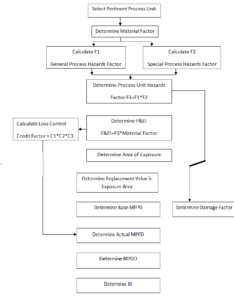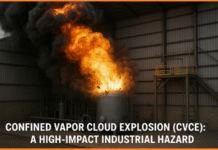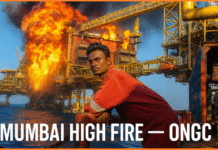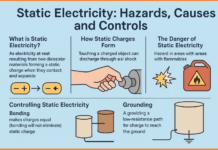The hazard classification guide developed by the Dow Chemical Company and published by the American Institute of Chemical Engineering, Dow (1994) (www.aiche.org), gives a method of evaluating the potential risk from a process and assessing the potential loss. A numerical “Fire and explosion index” (F&EI) is calculated, based on the nature of the process and the properties of the process materials. The larger value of the F&EI, the more hazardous the process.
Assessment of hazard
| Fire and explosion index range | Degree of hazard |
| 1-60 | Light |
| 61-96 | Moderate |
| 97-127 | Intermediate |
| 128-158 | Heavy |
| >159 | Severe |
To assess the potential hazard of a new plant, the index can be calculated after the Piping and Instrumentation and equipment layout diagrams have been prepared. In earlier versions of the guide the index was then used to determine what preventative and protection measures were needed. In the current version the preventative and protection measures that have been incorporated in the plant design to reduce the hazard-are taken into account when assessing the potential loss: in the form of loss control credit factors.
It is worthwhile estimating F & EI index at an early stage in the process design, as it will indicate whether alternative, less hazardous process routes should be considered. Only a brief outline of the method used to calculate the Dow F & EI will be given in this section. Judgement based on experience with similar process is needed to decide the magnitude of the various factors used in the calculation of the index and the loss control credit factors.
Calculation of the Dow F & EI
The procedure for calculating the index and the potential loss is set out. The first step is to identify the units that would have the greatest impact on the magnitude of any fire or explosion. The index is calculated for each of these units.
The basis of the F & EI is a Material Factor (MF). The MF is then multiplied by a Unit Hazard Factor, F3 to determine the F & EI for the process unit. The Unit Hazard factor is the product of two factors which take account of the hazards inherent in the operation of the particular process unit the general and special process hazards.
Material factor
The material factor is a measure of the intrinsic rate of energy release from the burning explosion or other chemical reaction of the material. Values for the MF for over 300

The most commonly used substances are given in the guide. The guide also includes a procedure for calculating the MF for substances not listed from knowledge of the flash point, (for dusts, dust explosion tests) and a reactivity value, Nr. The reactivity value is a qualitative description of the reactivity of the substance, and ranges from 0 for stable substances, to 4 for substances that are capable of unconfined detonation.
In calculating the F&EI for unit the value for the material with the highest MF, which is present in significant quantities is used.
| MF | Flash Point °C | Heat of combustion MJ/kg | |
| Acetaldehyde | 24 | -39 | 24.4 |
| Acetone | 16 | -20 | 28.6 |
| Acetylene | 40 | gas | 48.2 |
| Ammonia | 4 | gas | 18.6 |
| Benzene | 16 | -11 | 40.2 |
| Butane | 21 | gas | 45.8 |
| Chlorine | 1 | – | 0.0 |
| Cyclohexane | 16 | -20 | 43.5 |
| Ethyl alcohol | 16 | 13 | 26.8 |
| Hydrogen | 21 | gas | 120.0 |
| Nitroglycerine | 40 | – | 18.2 |
| Sulphur | 4 | – | 9.3 |
| Toluene | 16 | 40 | 31.3 |
| Vinyl Chloride | 21 | gas | 18.6 |
- Exothermic chemical reactions: the penalty varies from 0.3 for a mild exotherm, such as hydrogenation, to 1.25 for a particularly sensitive exotherm, such as nitration.
- Endothermic processes: penalty of 0.2 is applied to reactors only. It is increased to 0.4 if the reactor is heated by the combustion of a fuel.
- Materials handling and transfer: this penalty takes account of the hazard involved in the handling, transfer and warehousing of the material.
- Enclosed or indoor process units: account for the additional hazard where ventilation is restricted.
- Access of emergency equipment: areas not having adequate access are penalised. Minimum requirement is access from two sides.
- Draining and spill control: penalises design conditions that would cause large spills of flammable material adjacent to process equipment such as inadequate design of drainage.
Special process hazards
The special process hazards are factors that are known from experience to contribute to the probability of an incident involving loss.
- Toxic materials: the presence of toxic substances after an incident will make the task of the emergency personnel more difficult. The factor applied ranges from 0 for non-toxic materials, to 0.8 for substances that can cause death after short exposure.
- Sub-atmospheric pressure: allows for the hazard of air leakage into equipment. It is only applied for pressure less than 500 mmHg (9.5 bar).
- Operation in or near flammable range: cover for the possibility of air mixing with material in equipment or storage tanks, under conditions where the mixture will be within the explosive range.
- Dust explosion: covers for the possibility of a dust explosion. The degree of risk is largely determined by the particle size. The penalty factor varies from 0.25 for particles above 175 μm, to 2.0 for particles below 75 μm.
- Relief pressure: this penalty accounts for the effect of pressure on the rate of leakage, should be a leak occur. Equipment design and operation becomes more critical as the operating pressure is increased. The factor to apply depends on the relief device setting and the physical nature of the process material.
- Low temperature: this factor allows for the possibility of brittle fracture occurring in carbon steel, or other metals, at low temperature.
- Quantity of flammable material: the potential loss will be greater the quantity of hazardous material in the process or in storage. The factor to apply depends on the physical state and hazardous nature of the process material, and the quantity of material.
- Corrosion and erosion: despite good design and materials selection, some corrosion problems may arise, both internally and externally. The factor to be applied depends on the anticipated corrosion rate.
- Leakage-joints and packing: this factor accounts for the possibility of leakage from gaskets. Pump and other shaft seals and packed glands. The factor varies from 0.1 where there is the possibility of minor leaks, to 1.5 for process that have slight glasses, bellows or other expansion joints.
- Use of fired heaters: the presence of boilers or furnaces, heated by the combustion of fuels, increases the probability of ignition should a leak of flammable material occur from a process unit. The risk involved will depend on the sitting of the fired equipment and the flash point of the process material.
- Hot oil heat exchange system: most special heat exchange fluids are flammable and are often used above their flash points; so their use in a unit increases the risk of fire or explosion. The factor to apply depends on the quantity and whether the fluid is above or below its flash point.
- Rotating equipment: this factor accounts for the hazard arising from the use of large pieces of rotating equipment: compressors, centrifuges, and some mixers.
Basic preventative and protective measure
The basic safety and fire protective measures that should be included in all chemical process design are listed below. This list is bases on that given in the Dow Guide, with some minor amendments.
- Adequate, and secure, water supplies for fire fighting.
- Correct structural design of vessels, piping, steel work.
- Pressure-relief devices.
- Corrosion-resistant materials and adequate corrosion allowances.
- Segregation of reactive materials.
- Earthing of electrical equipment.
- Safe location of auxiliary electrical equipment, transformers, switches gear.
- Provision of back-up utility supplies and services.
- Compliance with national codes and standards.
- Fail-safe instrumentation.
- Provision for access of emergency vehicles and the evacuation of personnel.
- Adequate drainage for spills and fire-fighting water.
- Insulation of hot surfaces.
- No glass equipment used for flammable or hazardous materials, unless no suitable alternative is available.
- Adequate separation of hazardous equipment.
- Protection of pipe racks and cable trays from fire.
- Provision of block valves on lines to main processing areas.
- Protection of fired equipment (heaters, furnaces) against accidental explosion and fire.
- Safe design and location of control rooms.






I appreciate the efforts to strengthen the EHS community there by make safe society.